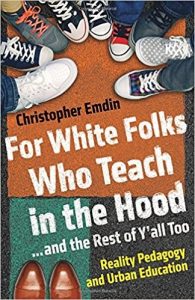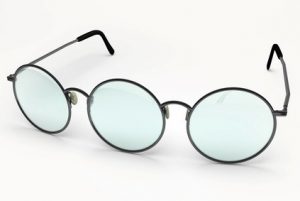As an instructor, I find the concept of lenses valuable. In teaching, lenses help me and the students see material from multiple angles or make connections between disciplines. They bring concepts, events, and people into focus. I first connected them with my teaching through my Digital Media & Design (DMD) colleague, Professor Clarissa Cegilo. Clarissa explained that when her students begin the DMD program, they typically possess a “user lens,” meaning they consume existing digital media products. By graduation, they have developed a “maker lens” that aids them in the future careers, whether as data analysts, animators, or web developers. What she strives to do in her course, Critical Perspectives on Digital Media, is create a third lens – one of digital media critic.

As critics, students possess a deeper understanding of technological innovation. They hone their skepticism about technology claims, large and small, and see the connections between technological and social changes. Their insights are needed as new devices, programs, and apps are developed and adopted. Lenses also appeared in English Professor James Lang’s book on academic dishonesty as he examined cheating through the lens of cognitive theory to discover how certain environments induce greater amounts of cheating. It is apparent that the use of lenses crosses academic disciplines and is a rich approach in developing strong course objectives and creating positive learning environments.
Outside the humanities and fine arts, lenses, and how we see students, factor greatly into Mathematics Professor Christopher Emdin’s For White Folks Who Teach in the Hood…and the Rest of Y’All Too: Reality Pedagogy and Urban Education.
For Emdin, the “hood” may be urban, rural, densely or sparsely populated, but it’s ultimately a place where a rules and controlled-based pedagogy is normalized and the student’s culture erased. Emdin argued that all too often, rigid administrative policies and an uninspired curriculum that seeks to erase a student’s cultural identity block instructors from seeing the bright and unique students in front of them.
To remedy this, Emdin advocates for reality pedagogy, which aims to meet “each student on his or her own cultural and emotional turf.” Furthermore, reality pedagogy acknowledges how previous teaching and learning experiences have scarred students and that this new viewpoint “works toward making students wholly visible to each other and to the teacher…”
To implement reality pedagogy into your course, Emdin suggested co-teaching lessons with students, having students lead discussions, and encouraging students to connect their cultural and personal experiences with topics discussed in the course. Together, students and the instructor “co-construct” a classroom where, according to Emdin, “every individual is perceived as having a distinct perspective and is given the opportunity to express that in the classroom.”
With so many examples of how individuals use lenses to enhance their teaching or understand thorny problems, I wondered what my lens would be. As previously mentioned, I teach in the DMD department and have worked on courses related to digital media and digital culture. But my research and training relates to foreign relations history, particularly between the United States and South Asia. What kind of lens can I offer that combines historical analysis of U.S. foreign relations with critiques of the contemporary digital world?
When I first began teaching in the DMD department, students would ask if other countries were familiar with memes, viral videos, and web content popular in the U.S. Some bits of digital media translated, but often each country had their own unique websites and social media networks, independent of the U.S. From there, students remarked that while we speak of the Internet as a singular endeavor, with a universal mission, it is actually different from country to country. Chinese authorities add strict regulations to Western search engines like Google and social media behemoths like Facebook and Twitter are banned, replaced with state-approved versions. In the European Union, digital privacy is protected by a series of rights including a “right-to-be-forgotten” – greater control of your online identity and the ability to stay anonymous on the web. In the U.S., while explicit censorship does not exist, privacy depends on the platform. A person’s browsing history can be sold to a third-party with you having little to no knowledge of it. The Internet does not get everything right, but it should remain a space for exploration, collaboration, and discovery.
The more I teach, conduct research, and think about the connections between foreign relations and digital technology, the better instructor I become. My students benefit from the multiple lenses produced by my varied research interests. Because of these diverse fields of study, my students question whether technological advancement travels at an equal pace.
They ask how does the user experience depend on the country? They see that the digital divides that exist in the United States – between those with greater formal education and in higher socio-economic backgrounds – and ponder whether they widened in other countries or have foreign nations discovered how to keep the user experience similar for nearly all of its citizens. Lastly, I want my students to see technology companies, like Google, Facebook, and Apple as non-state actors, with the power and influence to shape a country’s behavior, like its political system or mainstream culture.
The more lenses an instructor possesses, the better they see their students or have them understand different perspectives. One or two viewpoints are not enough. Multiple lenses correlate to a stronger sense of open-mindedness, critical thinking, and intellectual flexibility. Seeing people, actions, and events through different lenses demonstrates that instructors can adapt to different circumstances and see beyond the surface. More lenses help people see, process, and understand what is unfamiliar to them. Professor Christopher Emdin’s concept of reality pedagogy demonstrated how to “co-construct” a classroom that values all perspectives and encourages students to embrace their culture and individual identity. I recommend all instructors think about these different lenses and develop their own. What do they want to see and what should their students see? What lens should we look through next?